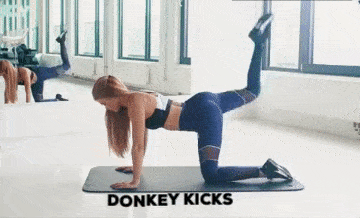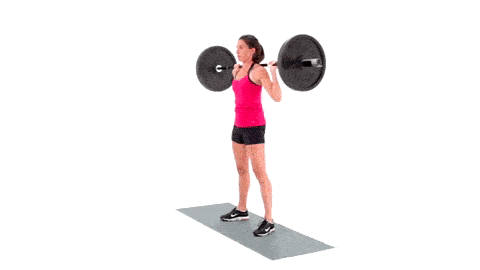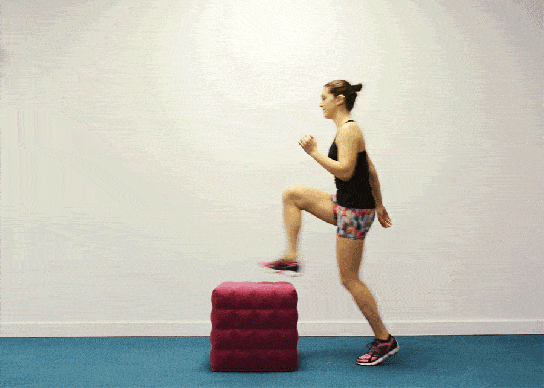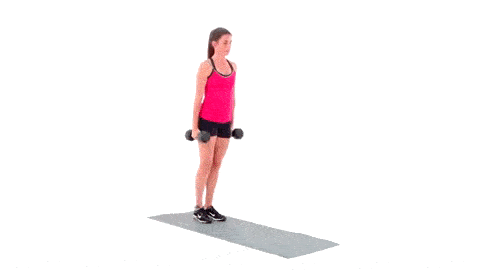How to grow hips and glutes, the method that ACTUALLY WORK!

Medically reviewed and approved by Nataniel Josue M.D.
Is it possible to grow your hips? I have known many women who desperately seek to shape and slim their buttocks and hips, without success.
To increase our hips and buttocks' size, you should engage in bodybuilding exercises to stimulate hypertrophy in this area and more than three times a week. You should also have a balanced diet with a lot of protein and a moderate amount of carbohydrates and fats.
I have seen women do aerobics with all their faith, religiously follow their diets, and cannot give their hips a good shape. It's possible because their plan to attack this problem is wrong, and they need a new one.
https://www.instagram.com/p/CDnykqqASWe/
If you take a look at fitness girls, jumpers, short-distance runners, or gymnasts, you will notice that none of them lack slender hips and well-formed buttocks. Genetics? Could be.
Maybe they were born with reduced hips and firm, hard buttocks? I've known several fitness girls who don't naturally have narrow hips and small buttocks.
The combination of fitness exercise and diet completely transformed them, including their hips and buttocks. And it can certainly do the same for you.
You may be interested in "How to get a good body shape"
- How to grow Your Hips and glutes
- WE ARE ALL DIFFERENT
- OUR BODY CONSTITUTION
- DO YOU HAVE A LOT TO LOSE?
- BEGINNER EXERCISE PROGRAM FOR THE BUTTOCKS AND HIPS
- THE GIANT SERIES
- TO BURN THE FAT RIGHT FROM THE START
- PHASE ONE: INTERMEDIATE LEVEL ROUTINE TO SHAPE HIPS AND BUTTOCKS
- PHASE TWO: INTERMEDIATE LEVEL ROUTINE TO SHAPE HIPS AND BUTTOCKS
- Exercises to shape the buttocks and hips
How to grow Your Hips and glutes

Many girls don't eat large amounts of food, but they eat what should not be missing from their diet: high-fat meals. And where does that fat go? To the thighs and buttocks.
Add to that a genetic predisposition to accumulate fat in that area and a lack of exercise, and you have a problem!
Our foods have lots of fat. The first effort a woman who wants to be slim in the buttocks and hips should drastically reduce her dietary fat intake.
Also, to widen and round off the hips, she has to eat mainly low glycemic index carbohydrates (salads, vegetables, cereals, and fruits) and high-quality protein.
Take some protein after each training session. The body needs it at these times to repair muscle tissue. Protein will also make you feel full and balance your blood sugar levels.
Eat frequently but in small amounts.
That will help speed up your metabolism and help you digest and process food better. Our recommendation is to eat 5-6 healthy meals a day.
Eat only nutritious foods.

Forget about junk food and industrial baked goods. Eat healthy, natural foods that provide the nutrients your body needs.
Eat proper amounts of the following foods:
- Lettuce
- Cabbages
- Carrots
- Chard
- Spinach
- Beets
- Cucumbers
- Asparagus
- Beans
- Lentils
- Brussels sprouts
- Mushrooms
- Tomatoes
- Potatoes
- Skimmed milk and yogurt
- Fresh fruit
- Whole grains
- Chicken or turkey (skinned)
- Fish, egg whites, oats
- Occasionally small portions of lean red meat.
- Always drink plenty of water.
If you want to know more about nutritious and healthy foods, read our article "The best 22 foods for our health according to science ".
Reduce your fat intake.
Consume less fat and be careful with the fat hidden in the food. That is essential to get the result you want.
Don't skip the diet
Training and exercise play a key role in getting a more prominent hip and butt, but eating is also essential. See a nutritionist or doctor, follow their advice, and do what's best for you.
You always want to be realistic about your expectations, but you must have faith that it is your body and that you can shape it according to your wishes with a little hard work and perseverance.
Do aerobic exercises

Everyone knows that aerobic exercise is essential for controlling weight and getting in shape, although sometimes it is not enough.
Few bodybuilders do aerobics, but almost all have toned buttocks and worked hips.
In contrast, many women who do a lot of aerobic exercises, and even instructors of that activity, have buttocks and hips in awful condition. The fact is that we have to do the right aerobics for our needs. If we want to strengthen our buttocks and shape our hips, we must do aerobic exercises that work in that area.
Cross-country skiing, climbing, or the simulator apparatus work better than the static bicycle, rowing, swimming, or cycling. I want you to get into aerobics but the most effective kind.
To lose weight, strengthen, and shape your buttocks, you should do aerobics five days a week, if possible first thing in the morning. If you are a beginner, I recommend a progressive program.
If you want to know the most effective exercises, read our article "What are the best fitness exercises for shaping the body?."
Do bodybuilding
Doing a bodybuilding program will help you greatly to increase your hips and buttocks beautifully and proportionately. Next, we will give you a program and some exercises to follow that will make you get those hips and buttocks you want.
If you are a beginner at the gym, you can find a spectacular workout in our article "Beginners Gym Routine. "
Variation of the training program
If you want to get a bigger butt and hips, you will need to try several training programs until you find the one that suits you best. We will leave you with the best exercises and the best training program to increase your buttocks and hips according to our experience.
Try these exercises that we will indicate to you and stay with the ones that work best. You have to change your workout from time to time and not stick to a particular movement.
WE ARE ALL DIFFERENT

We all have different hips and bodies. The first thing to understand is that the human being is not the product of cloning or cell replication.
We are all different. Some have, naturally, more fat. Others have a faster metabolism.
Some people were born with an athletic constitution and grew up in an energetic environment that gave them an advantage when they reached their adult years.
But whatever the size of your hips, you must accept it and be happy with the physical expression of your being.
No one is perfect. Besides, there are more important things in life than hips and buttocks. What can we say then about, for example, love and happiness?
Women have more fat than men and accumulate them differently.
While men have their highest accumulation in the abdominal area, women have their most significant gathering in the hips, thighs, and buttocks.
Statistically, doctors say that they have a pear type (large thighs and hips concerning the torso if you are overweight). You are less likely to have a heart attack than with the apple type construction (that of fat men, with a preponderance of the upper part).
However, when it comes to getting in shape, women have a worse time.
With the right kind of exercise, a persistent workout, and a balanced, low-fat diet, anyone can improve their buttocks – and adding aerobics will trim away all the fat and give the area sensuality and firmness!
OUR BODY CONSTITUTION
Types of women's metabolism: such as increasing hip and buttock size.
Another essential factor is physical biotype. Women can be:
- Ectomorphic - (small structure, little muscle, usually higher and faster metabolism).
- The mesomorphic type (more muscular and heavy-boned).
- Endomorphic - (more massive bone structure with more full hips, slower metabolism, adequate strength, but excess fat tissue).
The somatotype greatly determines the responses to exercise and the type of diet we should follow.
Only natural mesomorphs have a smooth start, with well-formed hips and buttocks. Most ectomorphs, despite their thinness, do not usually have the right buttocks.
Because the buttocks must be firm, dense, and durable, they will provide support to the naturally underlying fatty tissue, thus enhancing the feminine curves if they have muscle tone.
Many women with skinny types do not have the right muscle tone, which can worsen than a super overweight buttock.
- The ectomorphs need to achieve shape and muscle tone.
- The endomorph needs to lose excess size.
- And, the mesomorphs need to perform a combination of exercise and simple diet because heredity favors it.
Fitness can turn us into mesomorphs. The advantage is that we accelerate the metabolism by having more muscle size (muscles need caloric support, fats do not).
We can eat more and spend more calories with any level of exercise if we have more muscle.
But obese women have it harder than thin women. Obesity is considered ugly, and thinness is not (although it doesn't go to the extremes of the past decades).
Women have more fat and accumulate more proportionately in the buttocks and hips.
Their metabolisms are slower, and their muscle mass is lower. These are facts that are against us and, above all, against endomorphic women.
In general, and concerning our bodies, we have more mammoth pelvic bones (to facilitate advanced pregnancy burdens and allow delivery).
So, all women have different genetic structures, different metabolisms, and diverse activities. But none of this prevents us from getting in better shape, or lightening and strengthening our buttocks and hips.
DO YOU HAVE A LOT TO LOSE?

You have to lose fat if you want to enhance your hips and buttocks. If you are obese, it is best to talk to your doctor before starting a program.
They can also help you with your diet plans. Start by doing aerobics 2 or 3 times a week, starting with a five- to 10-minute walk, until you gradually build up to walking for half an hour, at a good pace, five times a week.
When I say "gradually," I mean slowly, thinking it may even take a year or more to get into the desired shape. As you progress, you can replace walking with other types of aerobics (dance, cycling, running, etc.)
BEGINNER EXERCISE PROGRAM FOR THE BUTTOCKS AND HIPS
Here I will only talk about specific exercises for the lower part. Still, you must remember that you must always do some activities for the torso, so you do not have difficulties maintaining the body's balance.
Eventually, and to achieve maximum efficiency, you should perform all these exercises in a continuous circuit, using the principle of giant series (a group of four or more practices, doing one set after another without rest).
Circuit training burns more calories (and calories from fat) per unit of time, but you must approach it carefully, and only after a period of adaptation.
I recommend that you start by doing your specific weight training exercises, two or three times a week, in the late afternoon or early evening, and then work up to five days a week.
The fact that you can do half an hour of aerobics and 30 to 40 minutes of weight training five times a week means you'll be attacking your buttocks and hips like never before.
Since we know that you haven't worked your buttocks and hips, you don't need to start with weights or braces. All you need to do is get three or four sets of each exercise for 15 to 25 repetitions.
You should do the exercises slowly and with constant flexion and not take a break between them. That, however, will cost you some time.
The way of execution is fundamental; you must isolate the worked muscle as much as possible.
Hip flexion
Although, you can do the exercises standing up (and eventually fighting the resistance of a pulley), start it by sitting down.
- Keep your leg stiff.
- Raise it as high as you can and slowly lower it back to the starting position.
- Don't rest below.
- Continue the exercise until you have completed 15 to 25 repetitions.
- When you finish with one leg, change position, and do the same with the other leg.
Start with one set and work up to four. When you're feeling energetic, put weights on your ankles to make your muscles work harder.
Hip abduction
- Lying on your side, raise your leg straight up.
- If you bend your leg at the knee, the exercise will be more natural, as the leverage will be more favorable. You will also work on your gluteus medius.
- With your leg stiffened, the high fascia tensor, another hip abductor, comes into action.
- It is crucial to raise your leg without going forward or backward, which would mean giving a boost.
- Keep the tension throughout the exercise.
Hip adduction
This exercise starts with the same position as the previous one. However, here you have to keep one leg raised while the other one goes up to join it and work the muscles of the inner part.
It is a hard movement. To begin with, you will probably only be able to do one or two repetitions, but you will end up doing 15 or 25.
Hip extension or donkey kicks

- Starting position, on all fours.
- Raises each leg up and back (if the leg is bent, isolates the gluteus maximus; if rigid, works the biceps femoris or back of thigh).
- The four basic toning movements of the hip are flexion, extension, abduction, and adduction.
- You can also do rotations, but most of the other exercises work the muscles involved in that movement.

Lunges

It's essential for beginners. It is the first exercise for "intermediates" in terms of shaping the buttocks and hips.
- You must start it without weight.
- The conventional "lunge" is the one where you step forward with one leg, resting the foot of the other one on the ground (the tip).
- Return to the starting position and repeat as many times as necessary with each leg.
You can also do lateral "lunges," or with the back of the foot turned inward.
I usually do what I call the "Cory lunges," where instead of moving the leg forward; I slow it down and bend over. In that case, I work the gluteal muscles eccentrically.
A few words to round it off: Warm up before starting the exercise and warm-up afterward.
The connective tissue hardens with age, losing its elasticity, which is a factor intrinsically related to an injury.
Stretching and warming up helps prevent them.
Be patient, practice all the aspects of the program, eat well, and you will soon see the results. Soon you will have slimness in the hip area, and your buttocks will be firm and rounded, so there is no time to waste!
THE GIANT SERIES
To give firmness and shape to the buttocks and hips, I have proposed some exercises done consecutively, using the principle of Giant Series (4 to 5 activities done one after the other, with minimum rest between them or, if possible, without any stop).
That is the best way to train your stubborn buttocks and hips. Training with Giant Series in circuit format is hard. It burns a lot of calories and quickly shapes any part of the body.
But you have to be careful not to over-train. People who train for the competition are risking over-training. That is not a process you should use if we want to add some size.
The tripartite formula includes specific training of the buttocks and hips. Aerobics 4 or 5 times per week, giant fitness series of leg exercises, 4 to 5 times per week, and correct nutritional habits.
TO BURN THE FAT RIGHT FROM THE START

Women following the beginner's program should do hip flexions, hip abductions and adductions, hip extensions, and "lunges."
Most will begin by using only the weight of their legs, and some will be able to do so by wearing ankle braces.
However, you will soon be ready for a more advanced buttock and hip program, one that is harder and much more effective.
That will be a specific program with two phases. The first will use pulleys. You should be ready for it in three months of training (if you have been training similarly, you are most likely ready to start the intermediate program).
PHASE ONE: INTERMEDIATE LEVEL ROUTINE TO SHAPE HIPS AND BUTTOCKS
In this sequence, we must train the hips and buttocks four times a week. Monday, Wednesday, Friday, and Saturday, for example, and the rest of the days, we can do hill climbing and other specific aerobic exercises. And every day we eat correctly!
Remember that you did push-ups, adductions, and hip abductions in the beginner's program while sitting, kneeling, or lying on your stomach or side.
This time you're going to do the same movements with your leg attached to the pulley or your weight rolled to your ankles.
It starts with flexion, abduction, adduction, and then extensions. Then it moves on to a bar or dumbbell lunges.
Do 15 to 25 repetitions (until muscle failure) of each exercise, one set after another, until you complete the giant set. Repeat three times if you can. As always, the technique is critical. Move slowly instead of quickly (it is understood that in each of the repetitions, not on the whole).
A routine like this, if you work hard and repeat the Giant Series, for a total of 30 to 40 minutes, will consume a minimum of 400 calories.
Do this four times a week, plus aerobics another four times, and reduce your caloric intake by 200 calories a day (from fat, not protein or natural carbohydrates).
You can lose a little more than half a kilo per week, which is a reasonable loss rate for women who have few lbs. to lose.
PHASE TWO: INTERMEDIATE LEVEL ROUTINE TO SHAPE HIPS AND BUTTOCKS
Exercise table and routine to increase hips and buttocks. When the pulley routines start looking easy, you're ready for the intermediate phase.
Also, make 3 to 4 Giant Series, using the movements that we are going to describe. Do them 3 or 4 times a week, leaving one or two days between sessions so that the muscles can recover.
Keep doing the aerobics 3 or 4 times and eating correctly.
By then, you have probably eliminated the excess fat, but do not eat junk food again.
Eat a little more protein, complex carbohydrates, or fresh fruit. You'll find that your buttock and hip program will not only have reshaped those areas but will also have improved your cardiovascular condition, nutrition, and outlook for life.
Squats

It's still the best move for the buttocks and hips. Yes, it develops the buttocks, thighs, and hips, but what about it? It's all about muscle, firm flesh.
And the squat makes the buttocks firmer and rounder, but not bigger.
If you lift your heels slightly and keep a minimal front torso tilt, your buttocks will remain firm and rounded.
The squatting position with the feet resting on the ground favors the development of the lower part of the buttocks.
The significant separation between the feet is very positive. You should vary your style to work the hips, upper thighs, and buttocks from all possible angles.
For most of my career, I have treated the squat as if it were an exercise of a different entity, but to reduce and shape those two problem areas, you should not use the single series method.
Instead, make it the first and hardest move in your giant series. Do 20 to 25 repetitions in each of them.
Step-ups

Step-up was viral years ago, then it was forgotten, and now it is back in fashion to shape the buttocks, hips, and upper thighs.
I like to step up all my repetitions on one leg before moving on to the other. I also use the benches of different heights.
On the way down, you can either stop at the footbridge or go further down. I do 15 to 20 reps with each leg.
Lunges

As I consider them more natural and less dangerous than "step-ups" you can do "lunges" in the beginner's routine already described above.
Leg press

Many people forget this device, but it is direct and beneficial, especially if we place our feet "up and out" while climbing.
Again, I advise you to do the repetitions slowly and under strict control. Vary the position of your feet and do higher repetitions, from 25 to 30.
Femoral curl, lying down and standing

The femoral curl is one of the least appreciated exercises for shaping the back of the thighs.
However, its two modalities, standing and lying down, are excellent for that purpose.
You work the femoral biceps as hip extenders and knee flexors, and the buttocks in their role as hip extenders. Especially if at the end of the "curl," you try to lift the hip and back, providing a super contraction to the buttock.
I do 12 to 20 reps for each Giant Series.
Leg Extensions, Calve Raises, or Butt and Lower Back Extensions
The last exercise of my Giant Series I choose from these three:
- Leg Extensions (to balance the work of the femoral biceps).
- Calve raises (to provide the entire leg).
- Some form of lower-back gluteal extension, which could be hypertension, or face-down extensions, or dead weight with a flat back, emphasizing my buttocks or upper back thighs.
I rarely do less than 12 repetitions.
Exercises to shape the buttocks and hips
The first phase of intermediates
- 3 to 5 Giant Series, going from one to another with minimal or no rest.
- Hip flexion in a pulley. Do 15 to 25 repetitions.
- Hip abduction on a pulley. Do 15 to 25 reps.
- Hip extension (with bent or rigid leg). Do 15 to 25 reps.
- Lunges. Do 15 to 25 reps.
The second phase of Intermediate
- Squat. Do 15 to 25 reps.
- Step-ups. Do 15 to 20 repetitions.
- Athletic press. Do 20 to 30 reps.
- Leg Extensions, Heel Lifts, or Back Extensions. Do 12 to 25 reps.
If you want more tips to transform your body, do not hesitate to visit our fitness section.
[author] [author_image timthumb='on']https://buildyourbody.org/wp-content/uploads/2020/08/Nataniel-Josue-Alvarez.jpg[/author_image] [author_info]Article reviewed and approved by Dr. Nataniel Josué Alvarez. Medical Doctor graduated from Medical School Universidad Nacional Experimental Francisco de Miranda Área Ciencias de la Salud. •Awarded winner IV Science Fair of Research Methodology - April 2012 •Recipient of Asesor Estudiantil Institucional Scholarship •Thesis: Relationship Between Parasitosis, Anemia and Hygiene Habits in patients aged 20 yo 70 years old in Amuay, municipality of Los Taques, Falcón State, Venezuela •Thesis: Intervention Plan in Rural Healthcare in Monte Verde and La Puntica sectors, of the Amuay Community, Los Taques parish, Los Taques municipality, of the Falcón State, Venezuela. During the period March 2018 - July 2018[/author_info] [/author]
